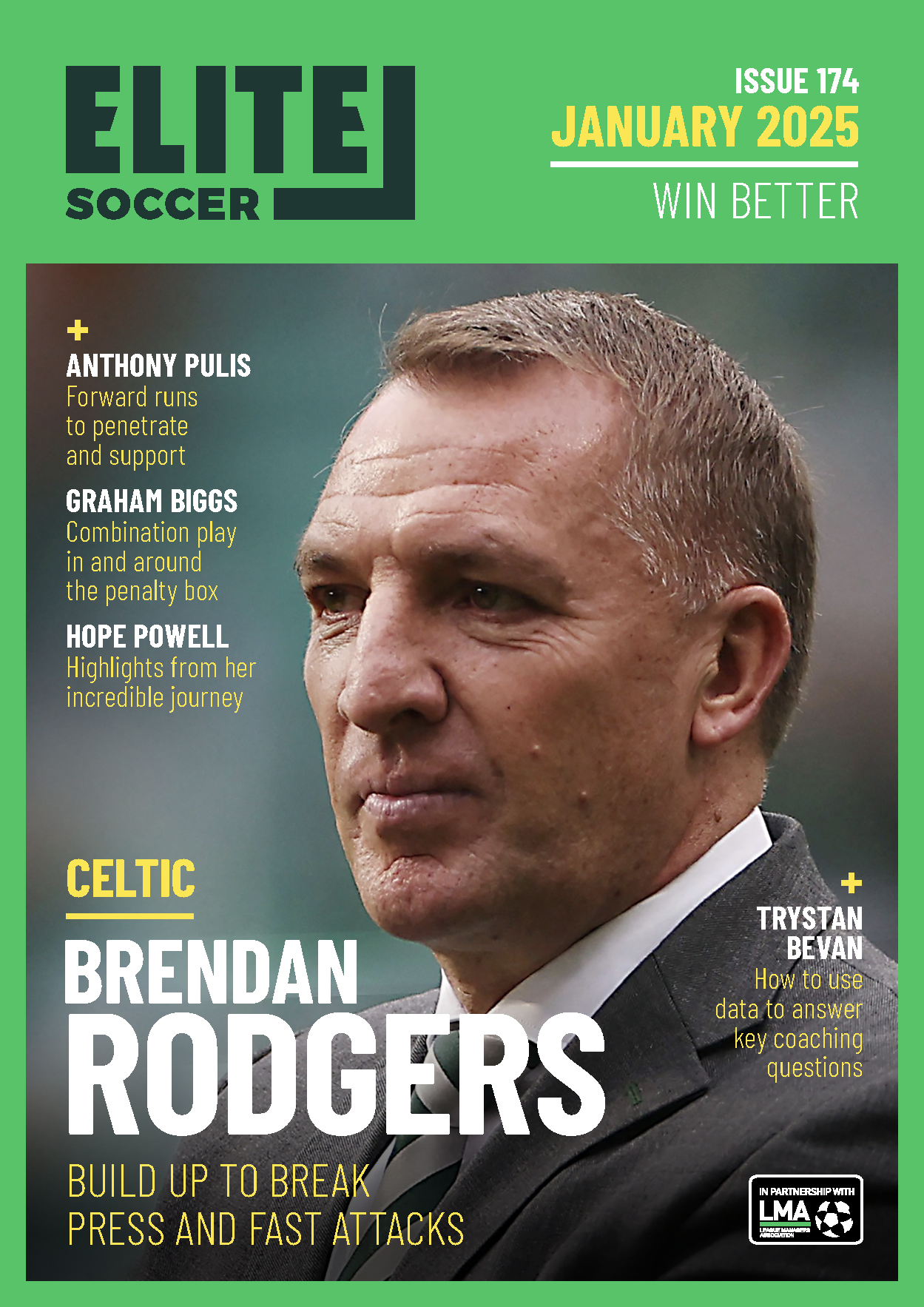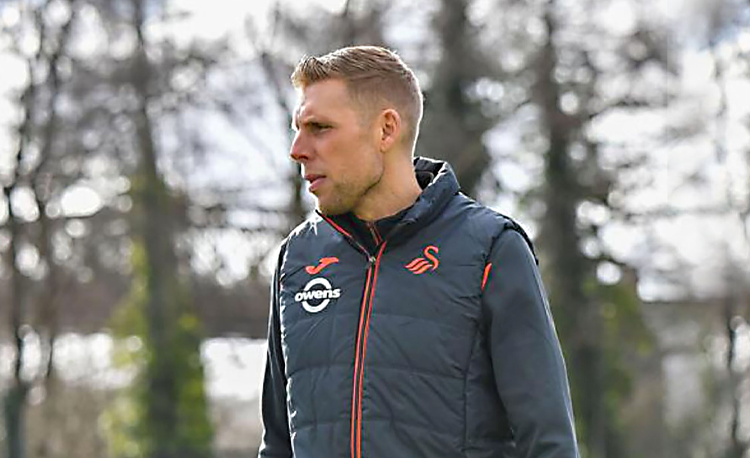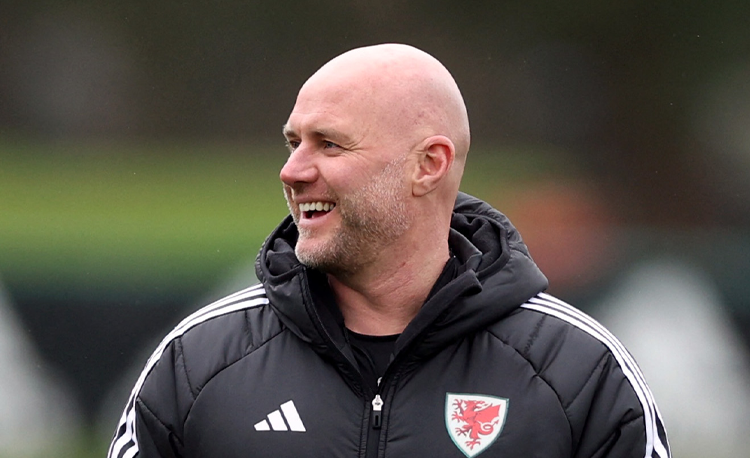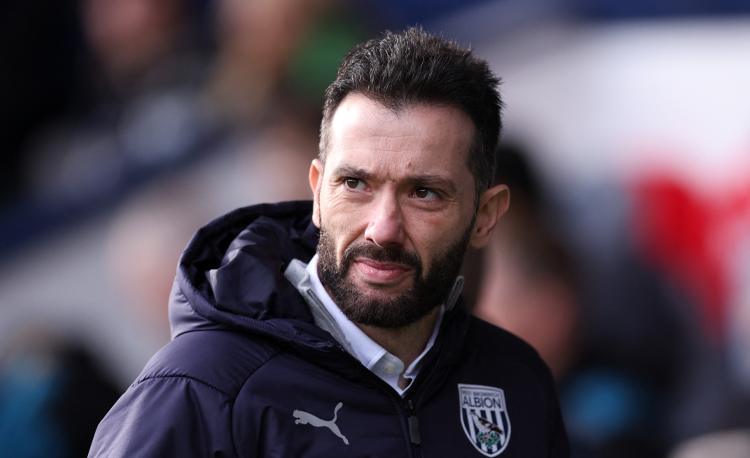You are viewing 1 of your 1 free articles
Third phase overload and finishing pattern
The finishing pattern part of the session is suited for strikers and wingers because it keeps them on their toes in terms of what they are doing and, of course, it’s what they love doing most - scoring goals.
| Area | Up to one third of a full size pitch |
| Equipment | Balls, bibs, poles, flat cones, mannequins, full size goal, 2 mini goals |
| No. of Players | Up to 22 outfield + 1 goalkeeper |
| Session Time |
Finishing pattern: at coach’s discretion |
The finishing pattern part of the session is suited for strikers and wingers because it keeps them on their toes in terms of what they are doing and, of course, it’s what they love doing most - scoring goals.
It’s also useful for them to understand the sort of movements - and when to adopt them - to bring defenders one way, and then exploit the space in behind moving the other way.
I would look to run this part of the session most days, but with variations in terms of the finishing drill.
The third phase overload part of the session is about finding a solution to go forward and break through and create a 3v2 overload and then sustain the attack, then defending against the counter (blocking passing lanes, pressing angles), and breaking down a low block.
Many times within a game you get overload situations, often it’s about the weight of the pass into the front man, the timing of the run and the decision making, then being alive behind the ball and sustaining the attack to go again.
Our league encourages more of a transition game. This drill we would run every two weeks (sometimes opened up into bigger spaces as an 11v11) as it reinforces our attacking philosophy: being creative, but also ruthless when certain situations present themselves.
“It reinforces our attacking philosophy: being creative, but also ruthless when certain situations present themselves”
FINISHING PATTERN
We set up with three mannequins situated evenly on the edge of the 18-yard box across the penalty arc and one each on the corners of the six-yard box, with one full size goal and one goalkeeper.
The player begins their run 25 yards out, in the inside right channel. They progress beyond the right mannequin in a 1v1 dribble situation, shooting at goal inside the area.
The same player now progresses to behind the central mannequin on the edge of the penalty area, choosing either side with an emphasis on their initial trigger movement. A second player plays the ball through, 25 yards out, and gets the one-two return, before shooting at goal first time inside the area, ideally with the side foot [1a].
[1a]
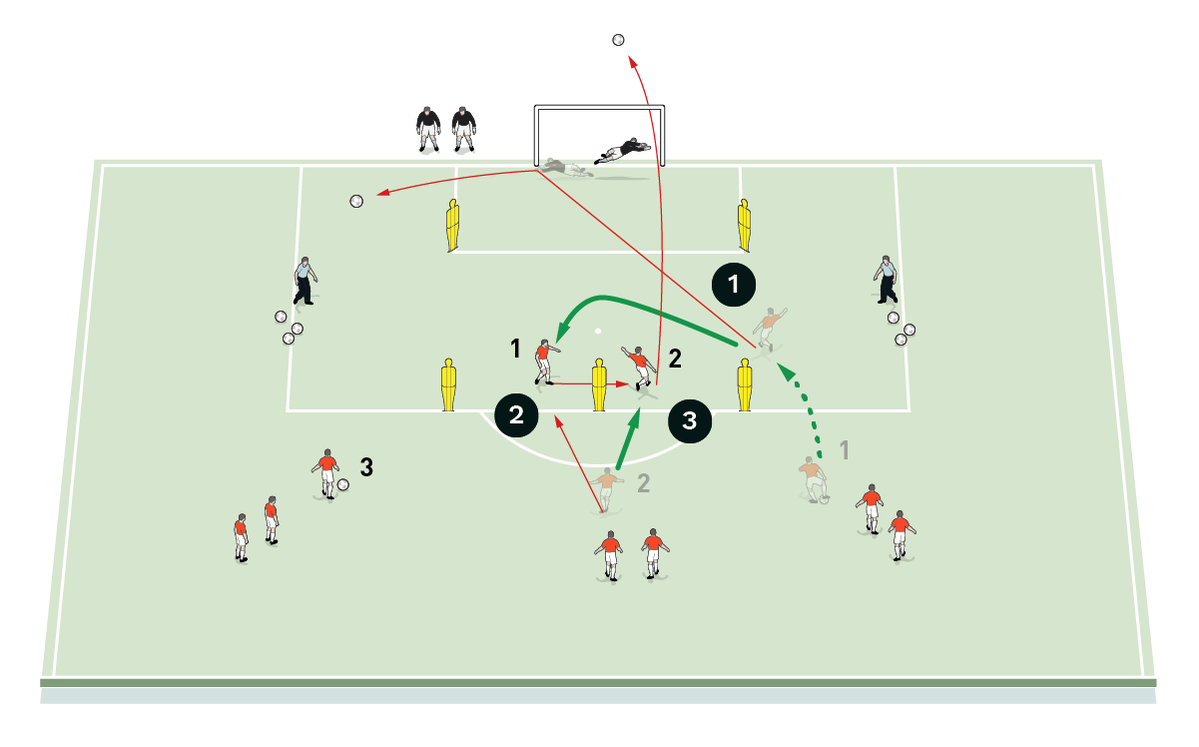
- The ball starts with player 1, who progresses beyond the mannequin before firing goalwards
- Player 1 moves to the centre, choosing a side to move before receiving a pass to player 2
- Player 1 returns the pass into player 2’s path before shooting for goal
“The player progresses to behind the central mannequin, choosing either side with an emphasis on their initial trigger movement”
A third player now progresses from the left-hand edge of the area towards the left mannequin, progressing into the area to take on the second player in a 1v1. The player will look to cut inside and then produce a side-foot finish [1b].
[1b]

-
Player 3 progresses from the left
- Player 3 cuts inside player 2, before shooting for goal
Now we’re looking for opposite movements from the three players - one going towards the near post, one centrally and one going far post as the coach delivers from the right-hand side, for a close-range finish [1c].
[1c]
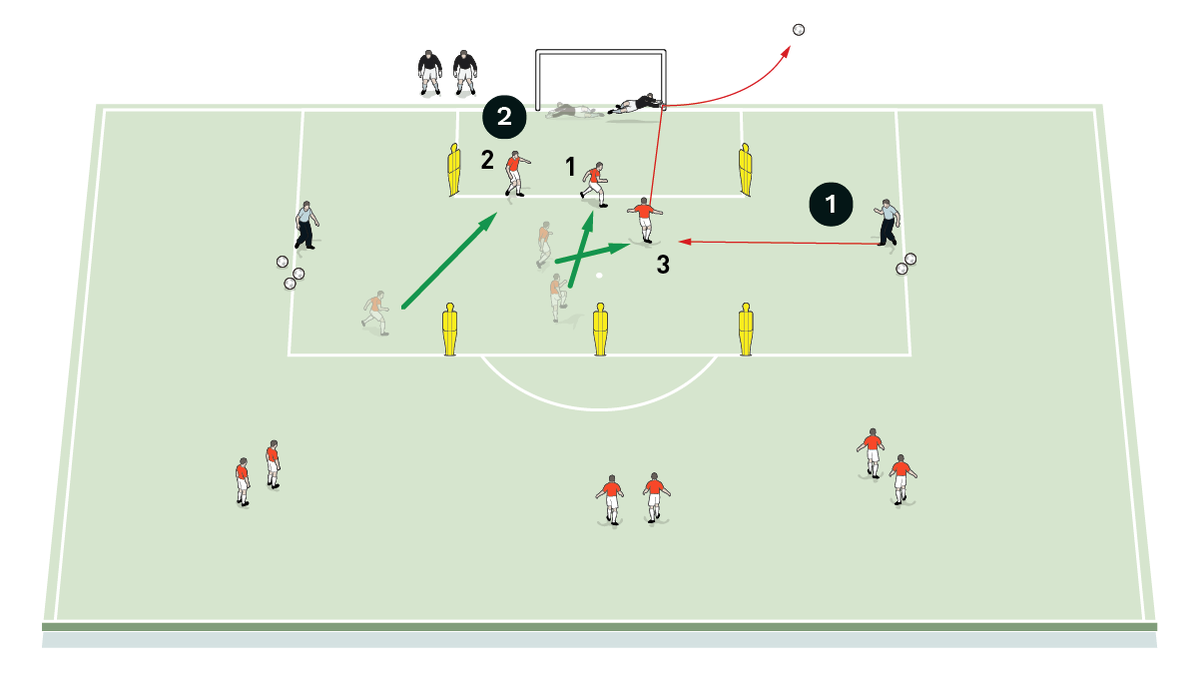
-
The coach now delivers from the right
- Player 1 and 2 choose either near post, or far post, before finishing
We’ll then look to vary the exercise by starting from the left rather than the right - with the coach again finishing off with a low cross to be finished from the right-hand side.
The session can be progressed by adding defenders in the box (perhaps on a rotation basis, if needed) to defend the cross, and also adding more attacking players on the outside to deliver into the box, rather than have a coach putting the ball in.
The session can be as long or short as you want. However, you don’t want a lot of players doing it as it then limits the amount of time each player gets to shoot.
“You don’t want a lot of players doing the session as it limits the amount of time each player gets to shoot”
THIRD PHASE OVERLOAD AND FINISHING PATTERN
An area the width of the penalty area and 36 yards long is used, with a full size goal - protected by goalkeeper - at one end, and two mini goals spaced 15 yards apart centrally at the other. Ten outfield players are used in a 5v5 - reds v blues in this instance.
The exercise begins with two reds keeping possession against one blue defender trying to read the passing direction. The reds will be spreading play, looking for a solution in order to advance up the pitch, while the blue defender looks to block the passing lane to their team-mate in the centre of the pitch.
The central red player receives the ball, taking out to the blue defender - and now two wide red players advance forward to create a 3v2 overload situation, with the two blue defenders situated centrally on the edge of their 18-yard box - while the other three blues defenders will be trying to get back to help their defenders out [2a].
[2a]
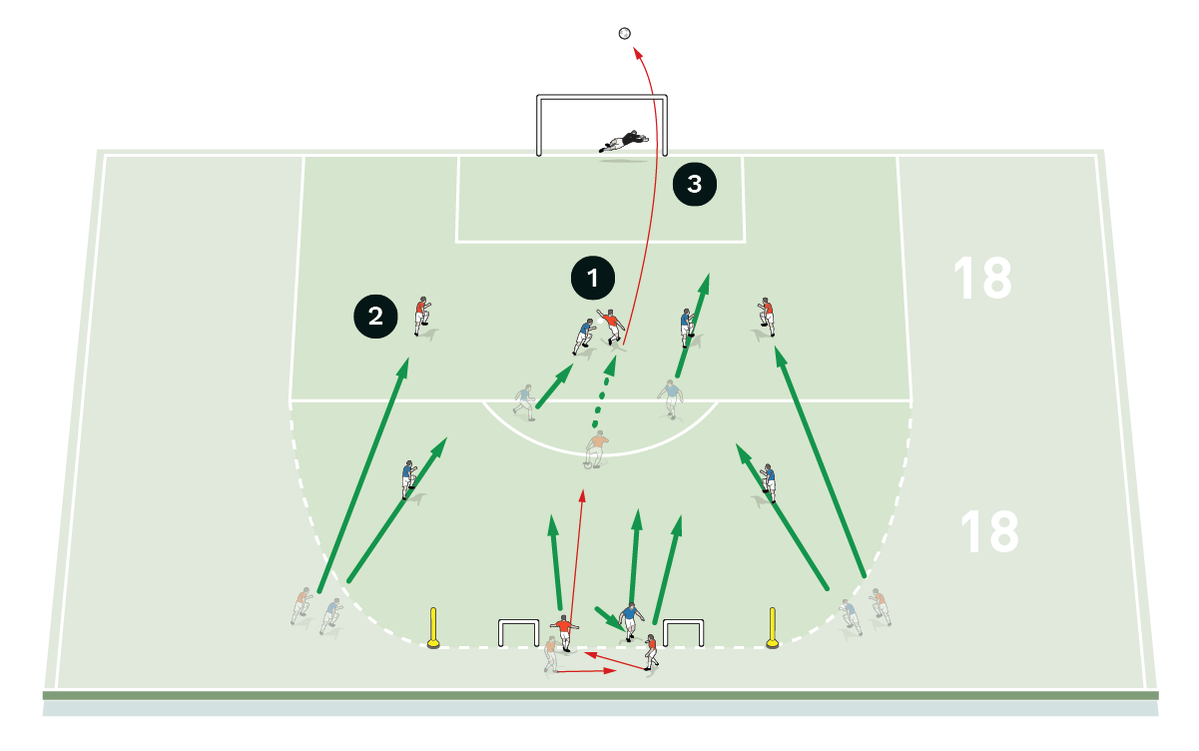
- Two reds keep possession against one blue defender, looking to find their team-mate in a central area
- The central red player receives the ball, taking out to the blue defender - and now two wide red players advance forward to create a 3v2 overload situation against two blues defenders
- The reds look to use the advantage to score
The reds can now choose how to use their extra player advantage, with the aim of scoring, as occurred in the first instance.
In the second move, play restarts with two reds in possession, who engineer another 3v2 - but the blue defending team win the ball back and now become the attacking team, breaking with the aim of scoring in one of the two mini goals [2b].
[2b]

- Two reds in possession engineer another 3v2 - but the blue defending team win the ball back and now become the attacking team
- The blues break with the aim of scoring in one of the mini goals
The aim of this break now from the red team defending the mini goals is in considering the pressing angle, as well as the covering position - with no goalkeeper being an additional consideration.
The ball is played back to a blue defender, who loses possession - and the reds build again, spreading play and keeping possession, waiting to create a passing angle.
The final move sees the blues sit back in a 4-1-0 shape (5v5), sitting deeper in a low block. Once they win possession back, with the reds further up the pitch, we’ll look to see a quick break, using angles beyond the red defenders, before finishing into one of the mini goals [2c].
[2c]

- The blues sit back in a low block, looking to win back possession
- With the reds further up the pitch, the blues will look to break quickly and score in one of the mini goals
As an additional challenge to the players in the 5v5, they’ll look to block the low block only within the width of the 18-yard box.
The session can be progressed to an 11v11, creating three zoned areas - first/second/third phase, trying to break through the initial press then beating midfielders (mid-block) and then the low block with an overload.
COACHING POINTS
What are the key things to look out for technically/tactically?
In the finishing pattern section, I’ll be looking for the movement of the player, firstly in the 1v1 situation - how can they get past the defender, then also where will they choose to receive and play the ball back for a 1-2, how will they drag the defender one way before moving in the opposite direction to receive and punch it back into their path? Everything must be a side-foot finish as most of the technique comes from the side foot - the control, the accuracy of the shot.
This situation is vital, whether it be training or a match day, it’s all about gaining that extra one per cent advantage through the movement on your opponent.
For the third phase overload section, I want to see players break through the lines with forward runs, and positive decision making. I’ll also be looking to see recovery runs when possession is lost.
What are the typical mistakes players might make and how could they avoid them?
In the finishing practice, the biggest negative for me would be if a player smashed the ball with the laces and thus would lose control on the strike.
In the third phase overload practice typical mistakes include taking too many touches and not picking out the right pass. I also don’t want to see too much time spent dwelling on the ball - the attacking team need to be ruthless, so quick passing is key.
Related Files
Editor's Picks
Using the goalkeeper in build-up play
Pressing principles
Intensive boxes drill with goals
Penetrating the final third
Creating and finishing
My philosophy
Pressing initiation
Compact team movement
Defensive organisation
Coaches' Testimonials

Alan Pardew

Arsène Wenger

Brendan Rodgers

Carlos Carvalhal

José Mourinho

Jürgen Klopp

Pep Guardiola

Roy Hodgson

Sir Alex Ferguson

Steven Gerrard
Coaches' Testimonials

Gerald Kearney, Downtown Las Vegas Soccer Club

Paul Butler, Florida, USA

Rick Shields, Springboro, USA

Tony Green, Pierrefonds Titans, Quebec, Canada
Join the world's leading coaches and managers and discover for yourself one of the best kept secrets in coaching. No other training tool on the planet is written or read by the calibre of names you’ll find in Elite Soccer.
In a recent survey 92% of subscribers said Elite Soccer makes them more confident, 89% said it makes them a more effective coach and 91% said it makes them more inspired.
Get Monthly Inspiration
All the latest techniques and approaches
Since 2010 Elite Soccer has given subscribers exclusive insight into the training ground practices of the world’s best coaches. Published in partnership with the League Managers Association we have unparalleled access to the leading lights in the English leagues, as well as a host of international managers.
Elite Soccer exclusively features sessions written by the coaches themselves. There are no observed sessions and no sessions “in the style of”, just first-hand advice delivered direct to you from the coach.


